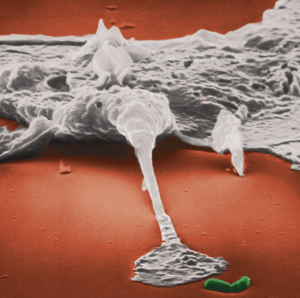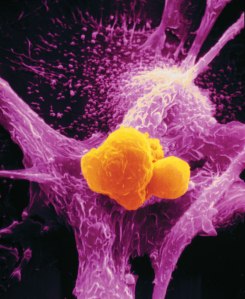The Immune System – Tutorial #4

Macophage reaching out to grab a bacterium.
Cancer cells give off chemical signals that attract microphages
Macrophages are always found in the wake of natural killer immune cells. The macrophage is an immune cell that plays an important role in attacking cancer cells. Most of the time macrophage cells remain in the body’s tissue in their “resting” state. They function primarily as the body’s detoxification system. In their resting state they remain stationary, taking sips of whatever is around them, keeping our tissue free of debris. They live for months in tissues, digesting and removing garbage such as dead and damaged cells, toxins, and other debris.
These immune cells are known as the sanitation department of our body. They are commonly referred to as big eaters. “Macro” means large and “phage” means “to eat.” So the macrophage is a big eater; it is also one of the most versatile of the immune cells.
Every once in a while some of these resting macrophages receive signals which alert them that there are invaders (something that is not-self) in their area. When this happens they become “activated.”
When a natural killer cell makes contact with a cancer cell, it immediately attacks the cancer cell. At the same time the natural killer cell secretes hormone-like messenger molecules (called cytokins) that immune cells use to communicate with one another.
Macrophages pick up this message, or danger signal, and become “activated.” This “activated” state puts them in a search and destroy mode. They grow bigger and their rate of testing and eating debris is quickened. They are looking for antigens.
If macrophage cells run across a tumor-antigen left behind from the destruction of a cancer cell, they know for sure the fight is on, and they shift to a “hyperactive” state. In its hyperactive state a macrophage is a killing machine! When hyperactive, macrophages produce and secrete large amounts of tumor necrosis factor (TNF). It can kill cancer cells and also activate other macrophage cells. In addition, tumor necrosis factor causes natural killer cells to begin to proliferate. One becomes two, two become four, four become eight, and on and on and on.
Soon there will be billions more natural killer cells to defend against cancer cells. It produces a “snowballing” effect that helps the immune system respond quickly and strongly. The natural killer cells send out signals that call other macrophage cells to the battlefield. Hyperactive macrophage cells send out signals to natural killer cells to proliferate; this creates more natural killer cells sending out signals calling more warriors to the battle. Soon billions of immune cells will be creating billions of cells, which in turn will create billions of cells.
To win, immune cells need to outnumber their enemy – they need to outnumber cancer cells.
Research has validated the fact that macrophage immune cells can “smell” cancer. There is a chemical signaling relationship. They migrate to the site of the cancer, and it is believed that they use their sense of “feel” to identify the cancer cells. Since tumor cells have unusual surface molecules it is believed that this abnormal expression of surface molecules on tumor cells allows activated macrophages to differentiate between cancer cells and normal cells.
 A macrophage cell (purple) will wrap itself over a cancer cell (orange, center) and seal the cancer cell in a pouch where it “digests” it. The macrophage then displays the cancer’s antigens on its surface. This is like posting “FBI wanted posters” at the post office. The macrophage starts a “manhunt” to find any cancer cells with this posted antigen throughout the body.
A macrophage cell (purple) will wrap itself over a cancer cell (orange, center) and seal the cancer cell in a pouch where it “digests” it. The macrophage then displays the cancer’s antigens on its surface. This is like posting “FBI wanted posters” at the post office. The macrophage starts a “manhunt” to find any cancer cells with this posted antigen throughout the body.
It is by this process that the nonspecific or innate immune system activates the specific or adaptive immune system and causes it to create another force of billions of immune cells (killer T- cells). These immune cells are designed to attack a specific intruder or cancer that has been identified. This process will be discussed in the next tutorial.



This is so interesting, but raises questions. With such an active defense system operating, how do the cancer cells win and cause us to become so ill?
Ron, wonderful question. According to the book, Stoppingcancer, by the American Institute for Cancer Research (AIRC), a healthy immune system can stop cancer in its tracks. Admittedly, not all immune systems stop all cancers all of the time, but it is true that most healthy immune systems stop most cancers. According to the AIRC, 75% of all cancers can be prevented with just diet and lifestyle changes. Based upon the scientific and medical literature I have reviewed, this is a very conservative estimate. Most people in our country have lifestyle habits that seriously suppress their immune system. A suppressed immune system gives cancer a chance to get a foothold.